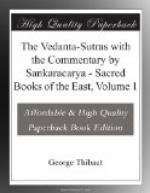is tri-coloured, because comprising fire, water, and
earth, produces many inanimate and animate beings
similar to itself, and is enjoyed by the souls fettered
by Nescience, while it is abandoned by those souls
which have attained true knowledge.—Nor
must we imagine that the distinction of individual
souls, which is implied in the preceding explanation,
involves that reality of the multiplicity of souls
which forms one of the tenets of other philosophical
schools. For the purport of the passage is to
intimate, not the multiplicity of souls, but the distinction
of the states of bondage and release. This latter
distinction is explained with reference to the multiplicity
of souls as ordinarily conceived; that multiplicity,
however, depends altogether on limiting adjuncts, and
is the unreal product of wrong knowledge merely; as
we know from scriptural passages such as, ’He
is the one God hidden in all beings, all-pervading,
the Self in all beings,’ &c.—The words
‘like the honey’ (in the Sutra) mean that
just as the sun, although not being honey, is represented
as honey (Ch. Up. III, 1), and speech as
a cow (B/ri/. Up. V, 8), and the heavenly
world, &c. as the fires (B/ri/. Up. VI, 2,
9), so here the causal matter, although not being
a she-goat, is metaphorically represented as one.
There is therefore nothing contrary to reason in the
circumstance of the term aja being used to denote the
aggregate of fire, water, and earth.
11. (The assertion that there is scriptural authority
for the pradhana, &c. can) also not (be based) on
the mention of the number (of the Sankhya categories),
on account of the diversity (of the categories) and
on account of the excess (over the number of those
categories).
The attempt to base the Sa@nkhya doctrine on the mantra
speaking of the aja having failed, the Sa@nkhya again
comes forward and points to another mantra: ’He
in whom the five “five-people” and the
ether rest, him alone I believe to be the Self; I
who know believe him to be Brahman’ (B/ri/.
Up. IV, 4, 17). In this mantra we have one
word which expresses the number five, viz. the
five-people, and then another word, viz. five,
which qualifies the former; these two words together
therefore convey the idea of five pentads, i.e.
twenty-five. Now as many beings as the number
twenty-five presupposes, just so many categories the
Sankhya system counts. Cp. Sa@nkhya Karika,
3: ’The fundamental causal substance (i.e.
the pradhana) is not an effect. Seven (substances),
viz. the Great one (Intellect), and so on, are
causal substances as well as effects. Sixteen
are effects. The soul is neither a causal substance
nor an effect.’ As therefore the number
twenty-five, which occurs in the scriptural passage
quoted, clearly refers to the twenty-five categories
taught in the Sa@nkhya-sm/ri/ti, it follows that the
doctrine of the pradhana, &c. rests on a scriptural
basis.




